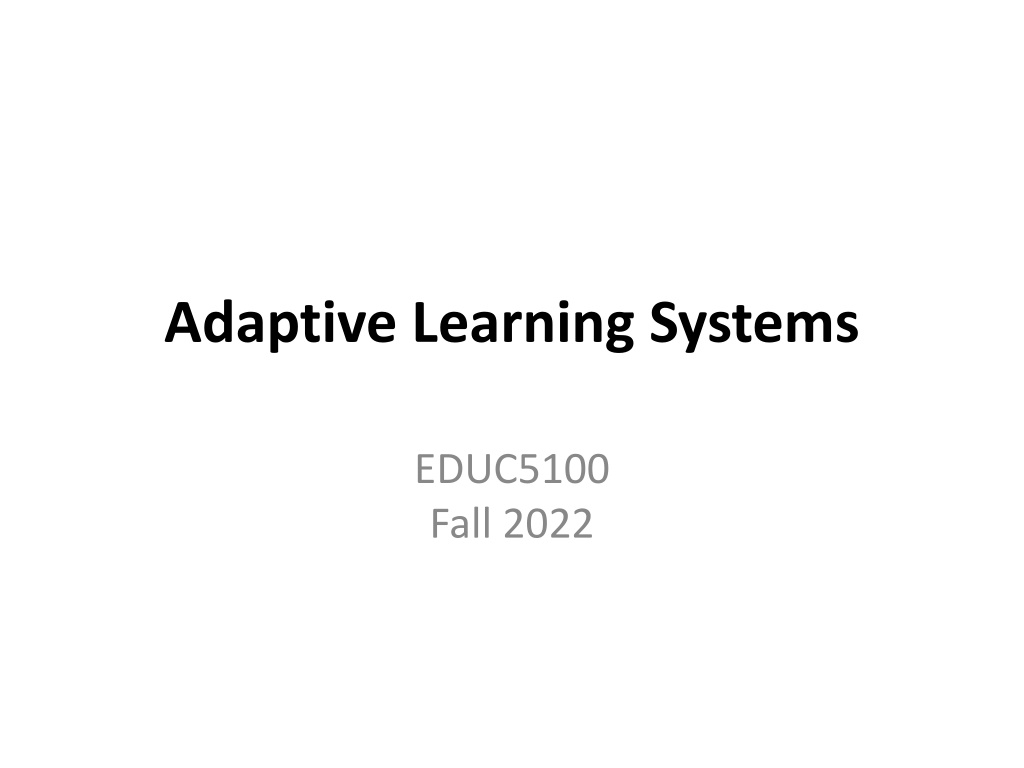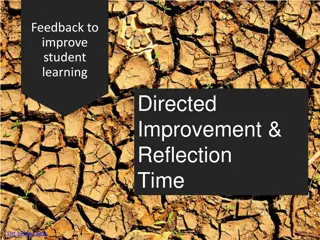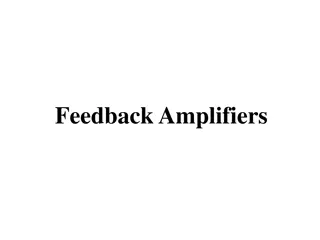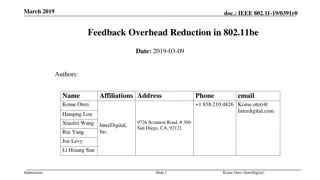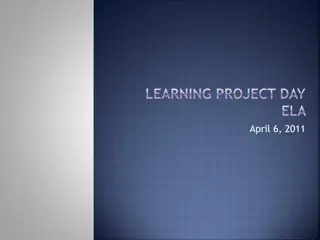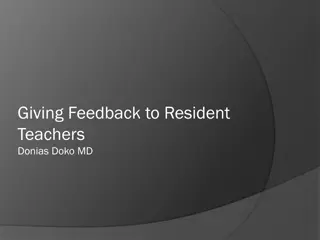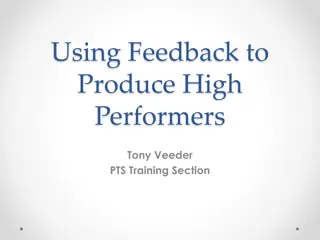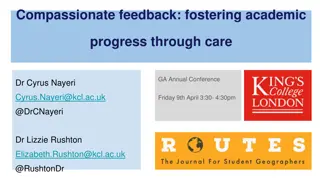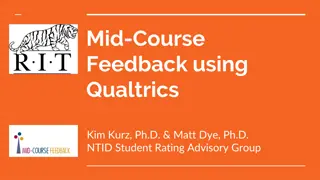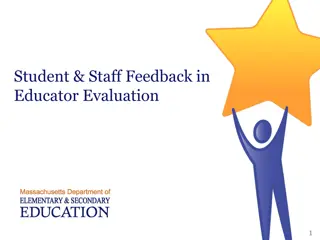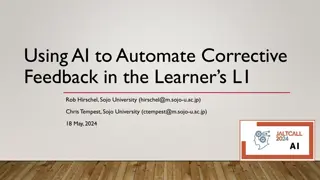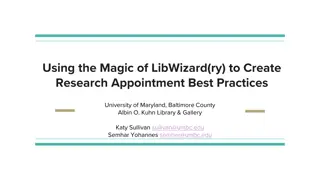Understanding Feedback in Learning Systems
Exploring the role of feedback in educational settings, this content delves into the concept of providing information to learners by various agents. It discusses the importance of feedback in guiding learning progress, highlighting examples of correctness feedback and correct answer feedback. The benefits and drawbacks of different feedback types are also examined to enhance understanding and implementation.
Download Presentation

Please find below an Image/Link to download the presentation.
The content on the website is provided AS IS for your information and personal use only. It may not be sold, licensed, or shared on other websites without obtaining consent from the author. Download presentation by click this link. If you encounter any issues during the download, it is possible that the publisher has removed the file from their server.
E N D
Presentation Transcript
Adaptive Learning Systems EDUC5100 Fall 2022
We continue today With a technology that one sees in a lot of contemporary learning systems Technology: hints and feedback Is it adaptive? It can be
We continue today Rich base of research literature going back decades Still a lot of gaps in that literature and promising directions never followed up on
Feedback In this review, feedback is conceptualized as information provided by an agent (e.g., teacher, peer, book, parent, self, experience) regarding aspects of one s performance or understanding. A teacher or parent can provide corrective information, a peer can provide an alternative strategy, a book can provide information to clarify ideas, a parent can provide encouragement, and a learner can look up the answer to evaluate the correctness of a response. Feedback thus is a consequence of performance. Hattie & Timperley (2007)
A student is doing math problems What s 3+6? 2x + 9 = 13. What s x? The student gives a wrong answer What s the simplest feedback we can give them?
Correctness feedback What are the benefits of correctness feedback? (Compared to no feedback at all) What are the drawbacks of correctness feedback? (Compared to no feedback at all)
The Next Step Up: Giving the correct answer The student gets the wrong answer We give them the right answer
The Next Step Up: Giving the correct answer The student gets the wrong answer We give them the right answer What are the benefits of correct answer feedback? (Compared to correctness feedback) What are the drawbacks of correct answer feedback? (Compared to correctness feedback)
Bug Messages What s a bug message?
Bug Message 2/3 + 1/4 = 3/7 Write down (on paper or your computer) a sentence you would give to a student who makes this error
Bug Message 2/3 + 1/4 = 3/7 Write down (on paper or your computer) a sentence you would give to a student who makes this error Let s read them out to the class
BUGGY/DEBUGGY (VanLehn, 1982, 1987) Early work in intelligent tutoring attempted to classify every possible bug and the reason it occurred Why don t we do this anymore, do you think?
BUGGY/DEBUGGY (VanLehn, 1982, 1987) 104 bugs in learning subtraction Are all these bugs important to specifically correct?
Preconceptions/Misconceptions There are some stable misconceptions/preconceptions (Thissen-Roe et al., 2004) But they are fairly rare and usually need a bigger intervention than a one-line message (Clement, 1983)
Contemporary Use of Bug Messages Typically for an easy-to-repair issue Working in the wrong part of the interface Wrong units or type of answer
Is Feedback Effective Overall? Yes Hattie & Timperley (2007) review 12 meta- analyses reviewing several hundred studies And the answer is yes
Is All Feedback Effective? No Wisniewski, Zierer, & Hattie (2020) re-review the literature and find that feedback can vary so much in effectiveness that it shouldn t be considered by itself
Delayed or Immediate Feedback? Should we tell the student their answer is wrong right away? Or should we give them time to figure it out on their own? What are the benefits and drawbacks of each?
Delayed or Immediate Feedback? A debate since Pressey (1950)/Brackbill et al. (1962) and still ongoing Delayed feedback better (Metcalfe et al., 2009; Mullet et al., 2014) Immediate feedback better (Kulik & Kulik, 1988; Lu et al., 2019) No difference (Butler & Roediger, 2008; Nakata, 2015; Fyfe et al., 2019)
Delayed or Immediate Feedback? What s Going on Here In 1988, Kulik & Kulik said that it really depends on the design of the study That still seems to be the case today, with most studies on one side of the debate or the other poking at methodological flaws in the other side For example, Lu et al (2019) discovered longer time between hint and test for immediate feedback condition than delayed feedback conditions in Metcalfe s studies, and replicated those studies with equal time to test, getting the opposite result
Levels of Feedback (Hattie & Timperley, 2007) Does anyone remember these from the reading?
Levels of Feedback (Hattie & Timperley, 2007) Task performance Process of understanding how to do a task Regulatory or metacognitive processes Self/personal level (unrelated to the specifics of the task)
Feedback on Task Performance: Key Review Findings Generally effective Better when high-level rather than extremely specific Example in Hattie & Timperley: telling students how many degrees off their LOGO solution was leads students to focus on tweaking rather than deeper problems Most useful: simple feedback on simple problems
Feedback on Task Process: Key Review Findings Supporting students on detecting their errors is beneficial Helping students learn to identify cues that help them determine how to solve the problem is beneficial
Some notes (McKendree, 1990) Feedback more effective when it: Helps students understand when a procedure applies and doesn t apply Helps students see how to break down a problem into steps Thoughts? Comments?
Example: Adaptive Scaffolding of Error Detection/Correction (Mathan, 2003; Koedinger et al., 2009) When student makes an error in creating formula, system leads student through realizing that formula is incorrect, and inferring why the result is different than what was expected/desired Scaffolding skill in error correction
Results Led to better learning, transfer, retention
Feedback on Self-Regulation: Key Review Findings Effective if it helps students devote more effort to task and target their effort better Effective if it helps students know how and when to seek help Effective if it increases self-efficacy, but
Feedback on Self: Key Review Findings Praising student for their ability usually has negative effects
Hints On-demand learning supports Hints and help used inter-changeably in ITS literature
Hints: Simplest version Simply telling the student the answer Often called a bottom-out hint What are the advantages and drawbacks of offering bottom-out hints versus offering no hints?
Hints: Another simplest version Offering a single tip on demand What are the advantages and drawbacks of offering single tip versus no hints? What are the advantages and drawbacks of offering single tip versus bottom-out hints?
Hints: Another simplest version A lot of ways one can give a tip (Heiner et al., 2004) With different implications for learning outcomes For example, in young children learning to read, telling them the meaning of the word they were trying to read helped more than breaking down word into syllables (Heiner et al., 2004)
Multi-step hints System offers multiple hint levels, which student can click forward on Early levels orient student towards task goal Later levels explain process Final bottom-out hint
Multi-step hints System offers multiple hint levels, which student can click forward on Example from Aleven et al (2006)
Multi-step hints What are the benefits and drawbacks of multi- step hints? What would be some important considerations for getting them right?
Interactive Hints (Arroyo et al., 2000)
Interactive Hints Mixed results: interactive hints better for girls but worse for boys (Arroyo et al., 2000) Attempted replication: interactive hints no better for boys or girls (Pardos et al., 2011) Thoughts? Comments?
Video Hints (Ostrow & Heffernan, 2014)
Video Hints (Ostrow & Heffernan, 2014) Video hints associated with better learning Why might this be? Why hasn t this work been followed up why aren t more systems using this approach?
Hint use Hint use can be effective or ineffective
